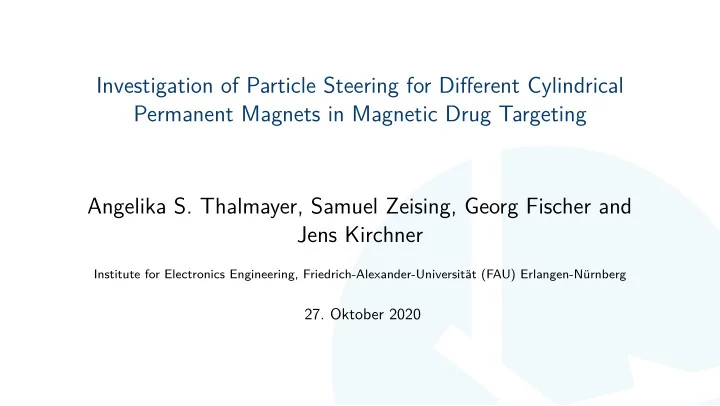

Investigation of Particle Steering for Different Cylindrical Permanent Magnets in Magnetic Drug Targeting Angelika S. Thalmayer, Samuel Zeising, Georg Fischer and Jens Kirchner Institute for Electronics Engineering, Friedrich-Alexander-Universit¨ at (FAU) Erlangen-N¨ urnberg 27. Oktober 2020
Overview ◮ Magnetic Drug Targeting ◮ Fundamentals ◮ Observed Model ◮ Results and Discussion ◮ Conclusion and Outlook 2 / 12
Magnetic Drug Targeting ◮ New promising cancer treatment ◮ Cancer-drug is bounded to magnetic nanoparticles ◮ Particles are pulled into tumor with a magnet ◮ Enables local chemotherapeutic treatment Magnetic nanoparticles 1 ⇒ Effectiveness of the treatment depends on a successful navigation of the particles through the cardiovascular system. 1H. Unterweger; et al. “Development and characterization of magnetic iron oxide nanoparticles with a cisplatin-bearing polymer coating for targeted drug delivery,” International Journal of Nanomedicine, 5 August 2014. 3 / 12
Fundamentals ◮ Superparamagnetic nanoparticles ◮ Motion of one particle (Newton’s symbol label second law): m p particle mass d v p d t = F m + F f particle/fluid velocity m p v p,f particle radius r p ◮ Magnetic force F m : permeability of vacuum µ 0 F m = 4 π r 3 susceptibility of particle/fluid µ 0 3 ( χ p − χ f ) χ p,f p 3 + ( χ p − χ f ) H · ∇ H magnetic field H 3 fluid viscosity η ◮ Drag force F f : F f = − 6 πη r p ( v p − v f ) 4 / 12
Observed Model deflection path direct path ◮ Transport from the left to the right within a 45 ◦ bifurcation vessel ◮ Particle packets of 5 × 100 particles ◮ Velocity of one particle is depicted by its color: red corresponds to a high and blue to a low normalized particle velocity 5 / 12
Simulation Parameters category symbol value unit label 2 cm radius r v vessel L 13 cm length 1 — relative permeability of the fluid µ f r p 350 nm radius kg/m 3 particle 2000 density ρ 4000 — relative permeability µ p cm 3 V 3 volume magnet 10 6 A/m saturation magnetization M sat v 3,6,12,24 ml/min fluid velocity varied rtl 0.5,1,2 — magnet’s radius to length ratio 6 / 12
Results: Influence of the Fluid Velocity v = 3 ml/min v = 24 ml/min ◮ Normalized velocity profile of the setup. The red color corresponds to a high and blue to a low normalized velocity ◮ Before the bifurcation: parabolic velocity profile ◮ At the bifurcation: turbulence ← → increasing with velocity ◮ Higher velocity in the middle of vessel → greater drag force 7 / 12
Results: Influence of the Gravitational Force ◮ Influence of the gravitational force decreases with an increasing fluid velocity ◮ Impact in direct path only observable for v = 3 ml/min 8 / 12
Results: Influence of the Magnet ◮ For lower velocities magnetic field is too strong → most particles trapped by magnet ◮ Magnetization directions: higher impact of magnet for radial magnetization ◮ Smaller rtl-value has greater influence on particle propagation 9 / 12
Discussion ◮ Particle steering depends on numerous parameters ◮ Influence of gravitation can be neglected for higher fluid velocities ◮ Particles in upper branch are trapped by magnet, the ones in the lower middle take desired direction ◮ For a fix fluid velocity and magnet, there must be an optimal zone to guide particles in the desired direction ◮ Deflection of particles towards a desired direction is difficult by using only one simple permanent magnet 10 / 12
Conclusion and Outlook ◮ Replacing permanent magnet by electromagnet, to fit applied magnetic field strength and its gradient to current fluid velocity ◮ To solve the trapping problem, the magnet can be switched on and off ◮ Figure out ”optimal zone“ for particle navigation ◮ Further optimization will be done 11 / 12
Thank you for your attention � Questions? 12 / 12
Recommend
More recommend